Strategic Management Report: Analyzing Dr. Pepper Snapple Group (2011)
VerifiedAdded on 2020/04/15
|17
|4229
|51
Report
AI Summary
This report provides a comprehensive strategic management analysis of Dr. Pepper Snapple Group (DPS), based on a 2011 case study. It begins with an abstract and proposed vision and actual mission statements. The analysis includes a Competitive Profile Matrix (CPM) comparing DPS to Coca-Cola and PepsiCo, along with an External Factor Evaluation (EFE) matrix assessing opportunities and threats. An internal audit examines DPS's strengths and weaknesses. Financial ratio analysis for 2009 and 2010 is presented, highlighting profitability, liquidity, and efficiency. An Internal Factor Evaluation (IFE) matrix further evaluates internal factors. Finally, the report discusses SWOT strategies derived from the internal and external analyses, offering insights into DPS's strategic positioning and recommendations for future growth and competitive advantage within the beverage industry.
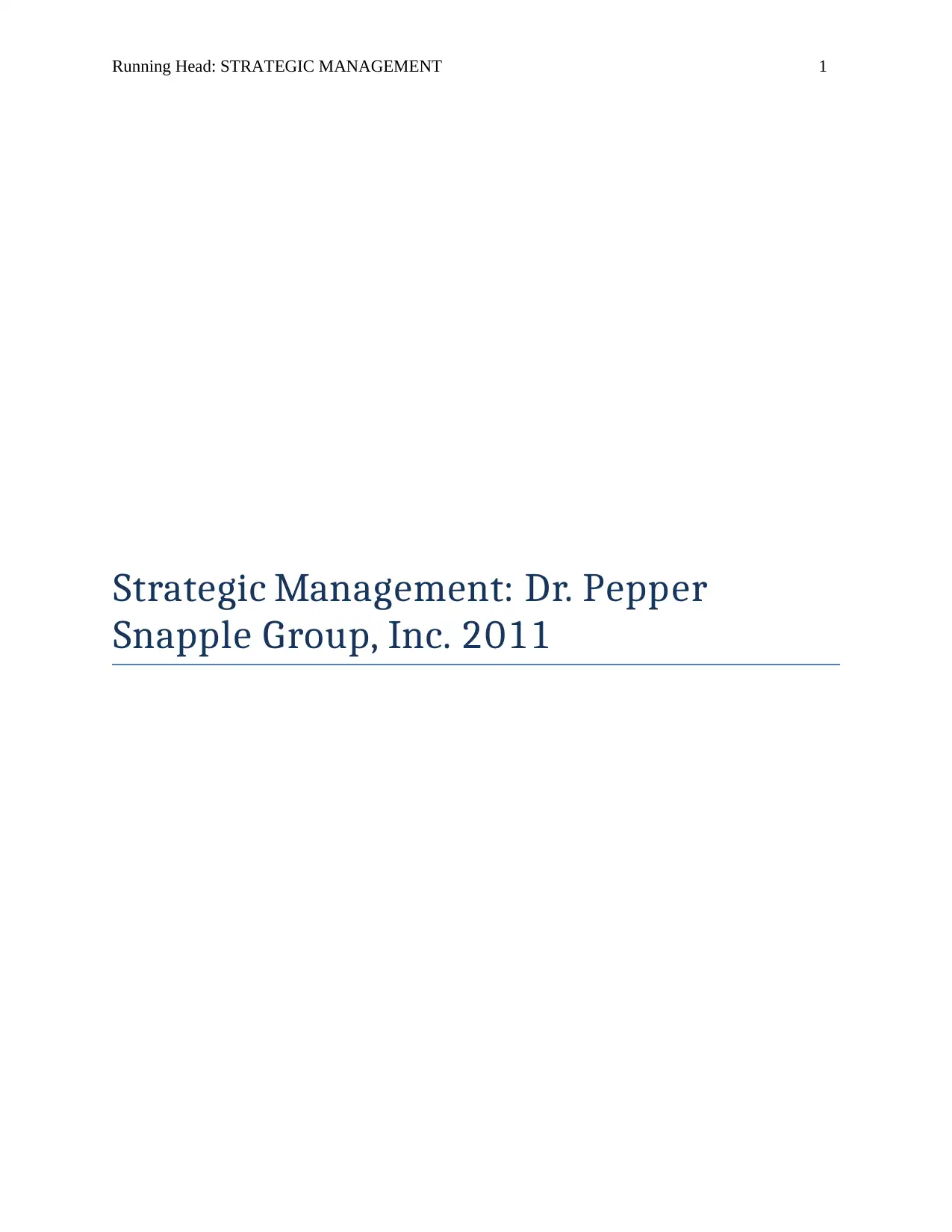
Running Head: STRATEGIC MANAGEMENT 1
Strategic Management: Dr. Pepper
Snapple Group, Inc. 2011
Strategic Management: Dr. Pepper
Snapple Group, Inc. 2011
Paraphrase This Document
Need a fresh take? Get an instant paraphrase of this document with our AI Paraphraser
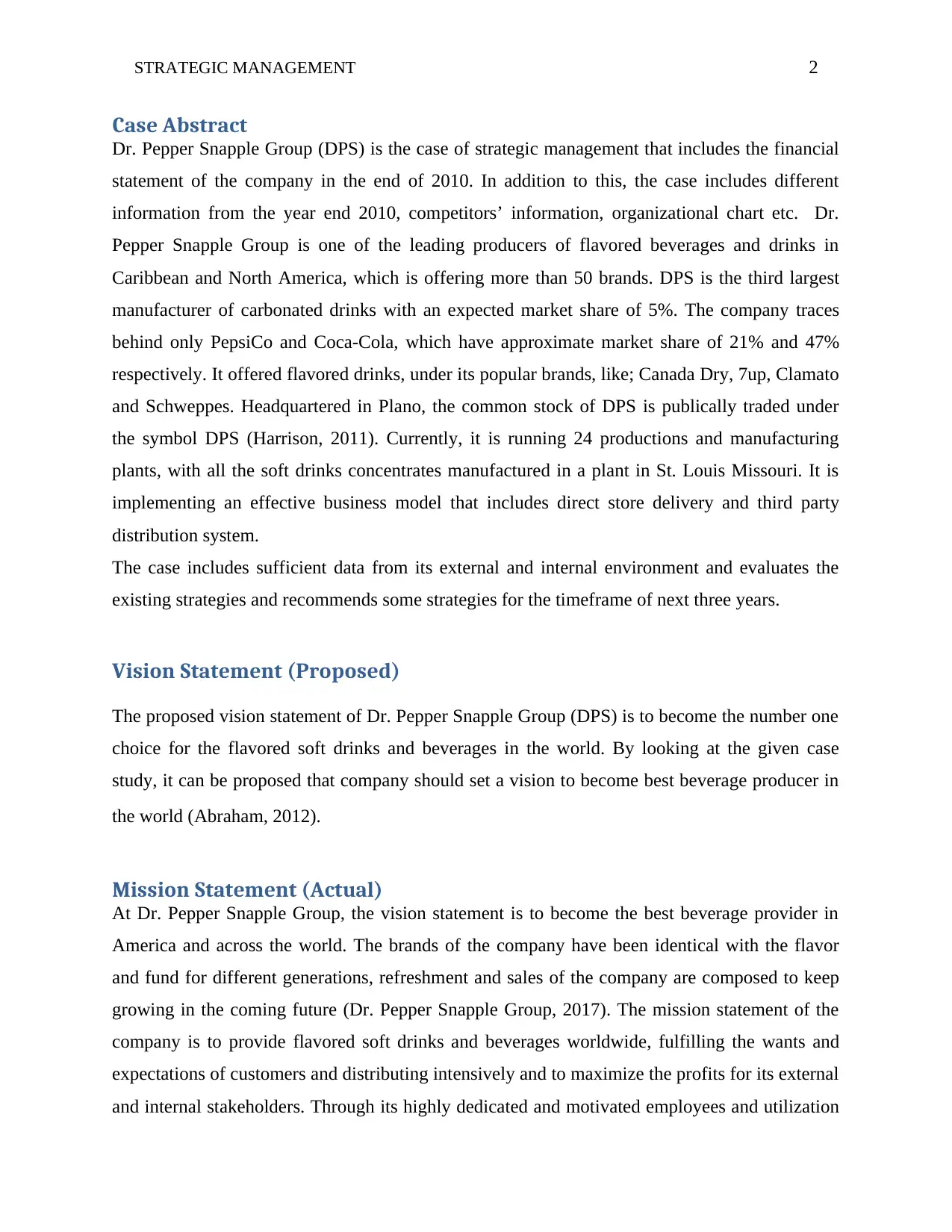
STRATEGIC MANAGEMENT 2
Case Abstract
Dr. Pepper Snapple Group (DPS) is the case of strategic management that includes the financial
statement of the company in the end of 2010. In addition to this, the case includes different
information from the year end 2010, competitors’ information, organizational chart etc. Dr.
Pepper Snapple Group is one of the leading producers of flavored beverages and drinks in
Caribbean and North America, which is offering more than 50 brands. DPS is the third largest
manufacturer of carbonated drinks with an expected market share of 5%. The company traces
behind only PepsiCo and Coca-Cola, which have approximate market share of 21% and 47%
respectively. It offered flavored drinks, under its popular brands, like; Canada Dry, 7up, Clamato
and Schweppes. Headquartered in Plano, the common stock of DPS is publically traded under
the symbol DPS (Harrison, 2011). Currently, it is running 24 productions and manufacturing
plants, with all the soft drinks concentrates manufactured in a plant in St. Louis Missouri. It is
implementing an effective business model that includes direct store delivery and third party
distribution system.
The case includes sufficient data from its external and internal environment and evaluates the
existing strategies and recommends some strategies for the timeframe of next three years.
Vision Statement (Proposed)
The proposed vision statement of Dr. Pepper Snapple Group (DPS) is to become the number one
choice for the flavored soft drinks and beverages in the world. By looking at the given case
study, it can be proposed that company should set a vision to become best beverage producer in
the world (Abraham, 2012).
Mission Statement (Actual)
At Dr. Pepper Snapple Group, the vision statement is to become the best beverage provider in
America and across the world. The brands of the company have been identical with the flavor
and fund for different generations, refreshment and sales of the company are composed to keep
growing in the coming future (Dr. Pepper Snapple Group, 2017). The mission statement of the
company is to provide flavored soft drinks and beverages worldwide, fulfilling the wants and
expectations of customers and distributing intensively and to maximize the profits for its external
and internal stakeholders. Through its highly dedicated and motivated employees and utilization
Case Abstract
Dr. Pepper Snapple Group (DPS) is the case of strategic management that includes the financial
statement of the company in the end of 2010. In addition to this, the case includes different
information from the year end 2010, competitors’ information, organizational chart etc. Dr.
Pepper Snapple Group is one of the leading producers of flavored beverages and drinks in
Caribbean and North America, which is offering more than 50 brands. DPS is the third largest
manufacturer of carbonated drinks with an expected market share of 5%. The company traces
behind only PepsiCo and Coca-Cola, which have approximate market share of 21% and 47%
respectively. It offered flavored drinks, under its popular brands, like; Canada Dry, 7up, Clamato
and Schweppes. Headquartered in Plano, the common stock of DPS is publically traded under
the symbol DPS (Harrison, 2011). Currently, it is running 24 productions and manufacturing
plants, with all the soft drinks concentrates manufactured in a plant in St. Louis Missouri. It is
implementing an effective business model that includes direct store delivery and third party
distribution system.
The case includes sufficient data from its external and internal environment and evaluates the
existing strategies and recommends some strategies for the timeframe of next three years.
Vision Statement (Proposed)
The proposed vision statement of Dr. Pepper Snapple Group (DPS) is to become the number one
choice for the flavored soft drinks and beverages in the world. By looking at the given case
study, it can be proposed that company should set a vision to become best beverage producer in
the world (Abraham, 2012).
Mission Statement (Actual)
At Dr. Pepper Snapple Group, the vision statement is to become the best beverage provider in
America and across the world. The brands of the company have been identical with the flavor
and fund for different generations, refreshment and sales of the company are composed to keep
growing in the coming future (Dr. Pepper Snapple Group, 2017). The mission statement of the
company is to provide flavored soft drinks and beverages worldwide, fulfilling the wants and
expectations of customers and distributing intensively and to maximize the profits for its external
and internal stakeholders. Through its highly dedicated and motivated employees and utilization
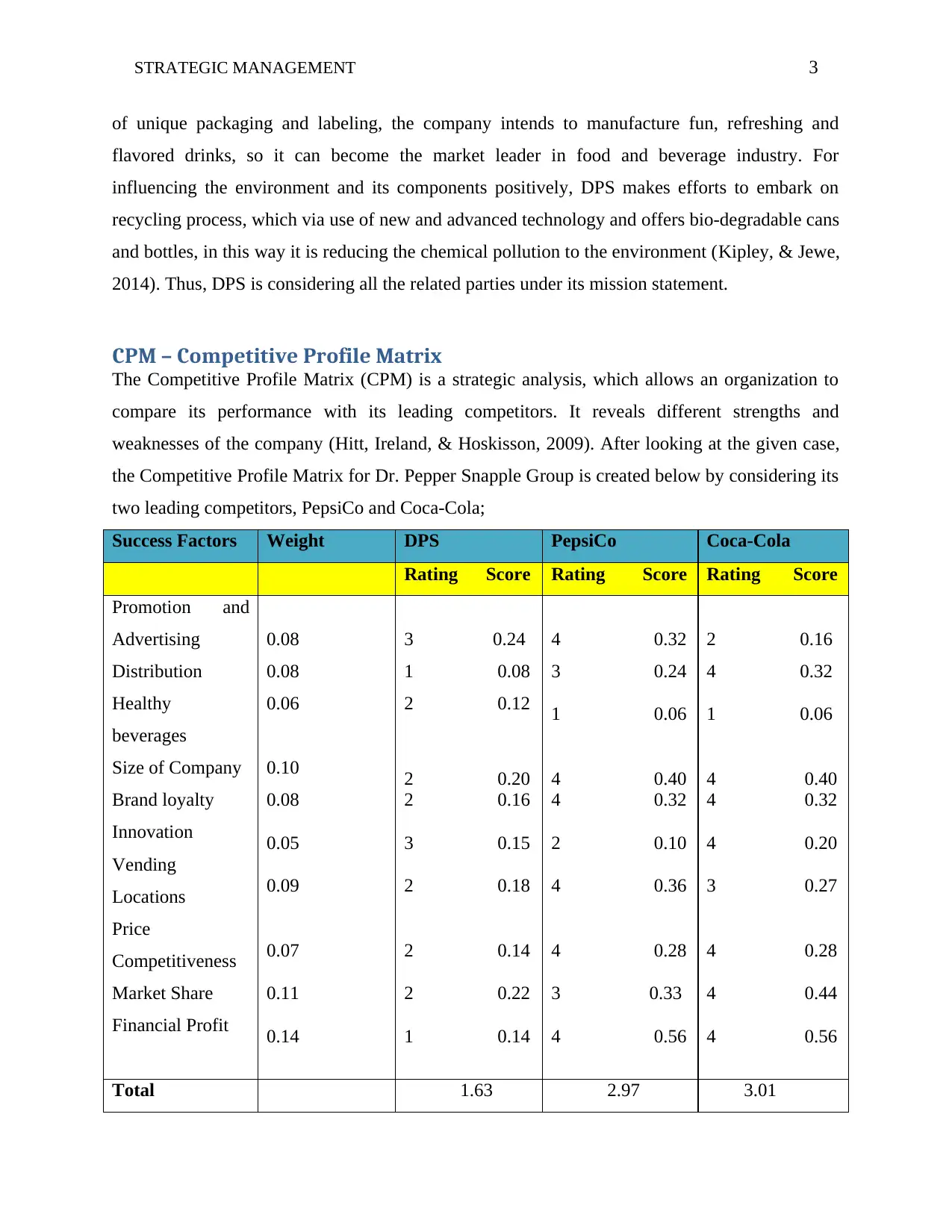
STRATEGIC MANAGEMENT 3
of unique packaging and labeling, the company intends to manufacture fun, refreshing and
flavored drinks, so it can become the market leader in food and beverage industry. For
influencing the environment and its components positively, DPS makes efforts to embark on
recycling process, which via use of new and advanced technology and offers bio-degradable cans
and bottles, in this way it is reducing the chemical pollution to the environment (Kipley, & Jewe,
2014). Thus, DPS is considering all the related parties under its mission statement.
CPM – Competitive Profile Matrix
The Competitive Profile Matrix (CPM) is a strategic analysis, which allows an organization to
compare its performance with its leading competitors. It reveals different strengths and
weaknesses of the company (Hitt, Ireland, & Hoskisson, 2009). After looking at the given case,
the Competitive Profile Matrix for Dr. Pepper Snapple Group is created below by considering its
two leading competitors, PepsiCo and Coca-Cola;
Success Factors Weight DPS PepsiCo Coca-Cola
Rating Score Rating Score Rating Score
Promotion and
Advertising
Distribution
Healthy
beverages
Size of Company
Brand loyalty
Innovation
Vending
Locations
Price
Competitiveness
Market Share
Financial Profit
0.08
0.08
0.06
0.10
0.08
0.05
0.09
0.07
0.11
0.14
3 0.24
1 0.08
2 0.12
2 0.20
2 0.16
3 0.15
2 0.18
2 0.14
2 0.22
1 0.14
4 0.32
3 0.24
1 0.06
4 0.40
4 0.32
2 0.10
4 0.36
4 0.28
3 0.33
4 0.56
2 0.16
4 0.32
1 0.06
4 0.40
4 0.32
4 0.20
3 0.27
4 0.28
4 0.44
4 0.56
Total 1.63 2.97 3.01
of unique packaging and labeling, the company intends to manufacture fun, refreshing and
flavored drinks, so it can become the market leader in food and beverage industry. For
influencing the environment and its components positively, DPS makes efforts to embark on
recycling process, which via use of new and advanced technology and offers bio-degradable cans
and bottles, in this way it is reducing the chemical pollution to the environment (Kipley, & Jewe,
2014). Thus, DPS is considering all the related parties under its mission statement.
CPM – Competitive Profile Matrix
The Competitive Profile Matrix (CPM) is a strategic analysis, which allows an organization to
compare its performance with its leading competitors. It reveals different strengths and
weaknesses of the company (Hitt, Ireland, & Hoskisson, 2009). After looking at the given case,
the Competitive Profile Matrix for Dr. Pepper Snapple Group is created below by considering its
two leading competitors, PepsiCo and Coca-Cola;
Success Factors Weight DPS PepsiCo Coca-Cola
Rating Score Rating Score Rating Score
Promotion and
Advertising
Distribution
Healthy
beverages
Size of Company
Brand loyalty
Innovation
Vending
Locations
Price
Competitiveness
Market Share
Financial Profit
0.08
0.08
0.06
0.10
0.08
0.05
0.09
0.07
0.11
0.14
3 0.24
1 0.08
2 0.12
2 0.20
2 0.16
3 0.15
2 0.18
2 0.14
2 0.22
1 0.14
4 0.32
3 0.24
1 0.06
4 0.40
4 0.32
2 0.10
4 0.36
4 0.28
3 0.33
4 0.56
2 0.16
4 0.32
1 0.06
4 0.40
4 0.32
4 0.20
3 0.27
4 0.28
4 0.44
4 0.56
Total 1.63 2.97 3.01
⊘ This is a preview!⊘
Do you want full access?
Subscribe today to unlock all pages.

Trusted by 1+ million students worldwide
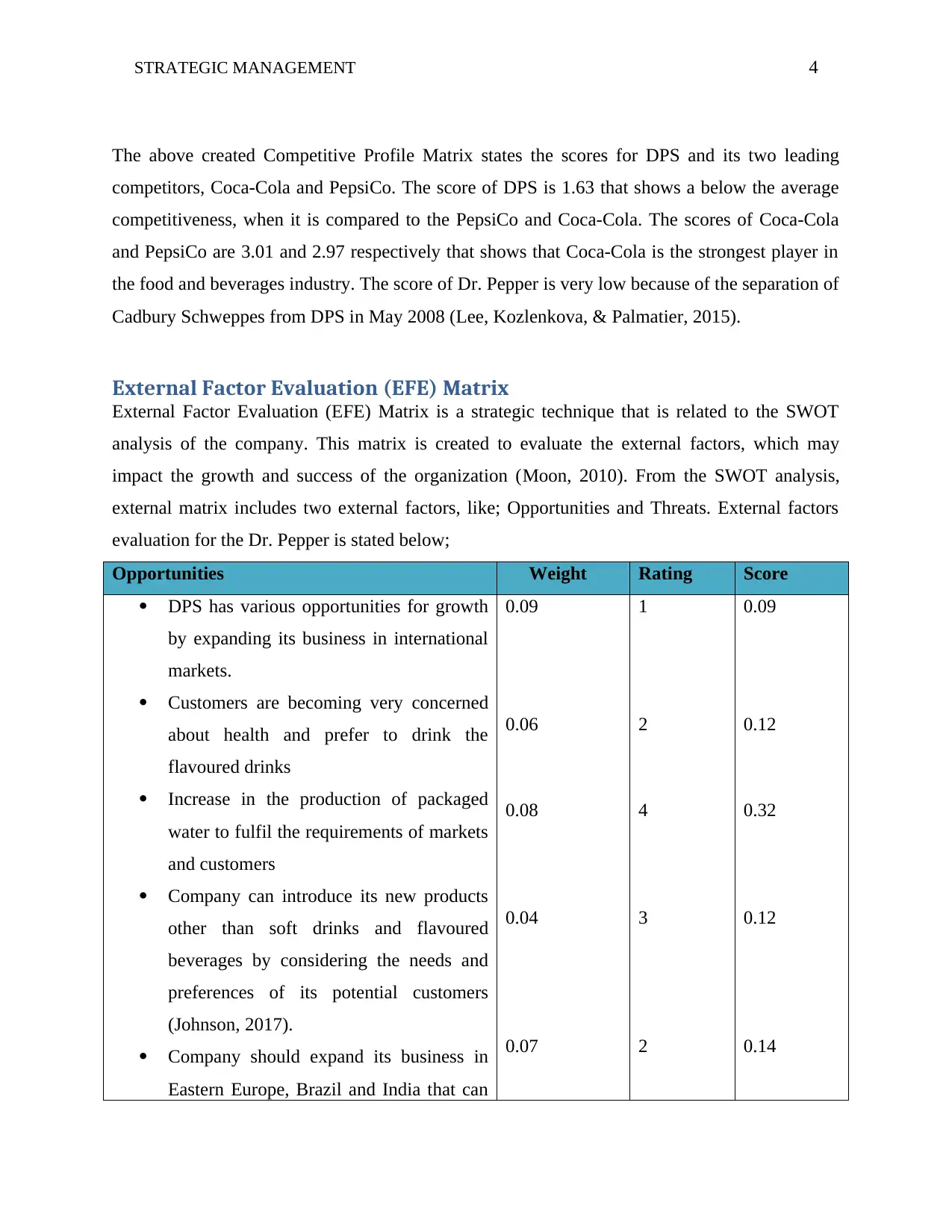
STRATEGIC MANAGEMENT 4
The above created Competitive Profile Matrix states the scores for DPS and its two leading
competitors, Coca-Cola and PepsiCo. The score of DPS is 1.63 that shows a below the average
competitiveness, when it is compared to the PepsiCo and Coca-Cola. The scores of Coca-Cola
and PepsiCo are 3.01 and 2.97 respectively that shows that Coca-Cola is the strongest player in
the food and beverages industry. The score of Dr. Pepper is very low because of the separation of
Cadbury Schweppes from DPS in May 2008 (Lee, Kozlenkova, & Palmatier, 2015).
External Factor Evaluation (EFE) Matrix
External Factor Evaluation (EFE) Matrix is a strategic technique that is related to the SWOT
analysis of the company. This matrix is created to evaluate the external factors, which may
impact the growth and success of the organization (Moon, 2010). From the SWOT analysis,
external matrix includes two external factors, like; Opportunities and Threats. External factors
evaluation for the Dr. Pepper is stated below;
Opportunities Weight Rating Score
DPS has various opportunities for growth
by expanding its business in international
markets.
Customers are becoming very concerned
about health and prefer to drink the
flavoured drinks
Increase in the production of packaged
water to fulfil the requirements of markets
and customers
Company can introduce its new products
other than soft drinks and flavoured
beverages by considering the needs and
preferences of its potential customers
(Johnson, 2017).
Company should expand its business in
Eastern Europe, Brazil and India that can
0.09
0.06
0.08
0.04
0.07
1
2
4
3
2
0.09
0.12
0.32
0.12
0.14
The above created Competitive Profile Matrix states the scores for DPS and its two leading
competitors, Coca-Cola and PepsiCo. The score of DPS is 1.63 that shows a below the average
competitiveness, when it is compared to the PepsiCo and Coca-Cola. The scores of Coca-Cola
and PepsiCo are 3.01 and 2.97 respectively that shows that Coca-Cola is the strongest player in
the food and beverages industry. The score of Dr. Pepper is very low because of the separation of
Cadbury Schweppes from DPS in May 2008 (Lee, Kozlenkova, & Palmatier, 2015).
External Factor Evaluation (EFE) Matrix
External Factor Evaluation (EFE) Matrix is a strategic technique that is related to the SWOT
analysis of the company. This matrix is created to evaluate the external factors, which may
impact the growth and success of the organization (Moon, 2010). From the SWOT analysis,
external matrix includes two external factors, like; Opportunities and Threats. External factors
evaluation for the Dr. Pepper is stated below;
Opportunities Weight Rating Score
DPS has various opportunities for growth
by expanding its business in international
markets.
Customers are becoming very concerned
about health and prefer to drink the
flavoured drinks
Increase in the production of packaged
water to fulfil the requirements of markets
and customers
Company can introduce its new products
other than soft drinks and flavoured
beverages by considering the needs and
preferences of its potential customers
(Johnson, 2017).
Company should expand its business in
Eastern Europe, Brazil and India that can
0.09
0.06
0.08
0.04
0.07
1
2
4
3
2
0.09
0.12
0.32
0.12
0.14
Paraphrase This Document
Need a fresh take? Get an instant paraphrase of this document with our AI Paraphraser
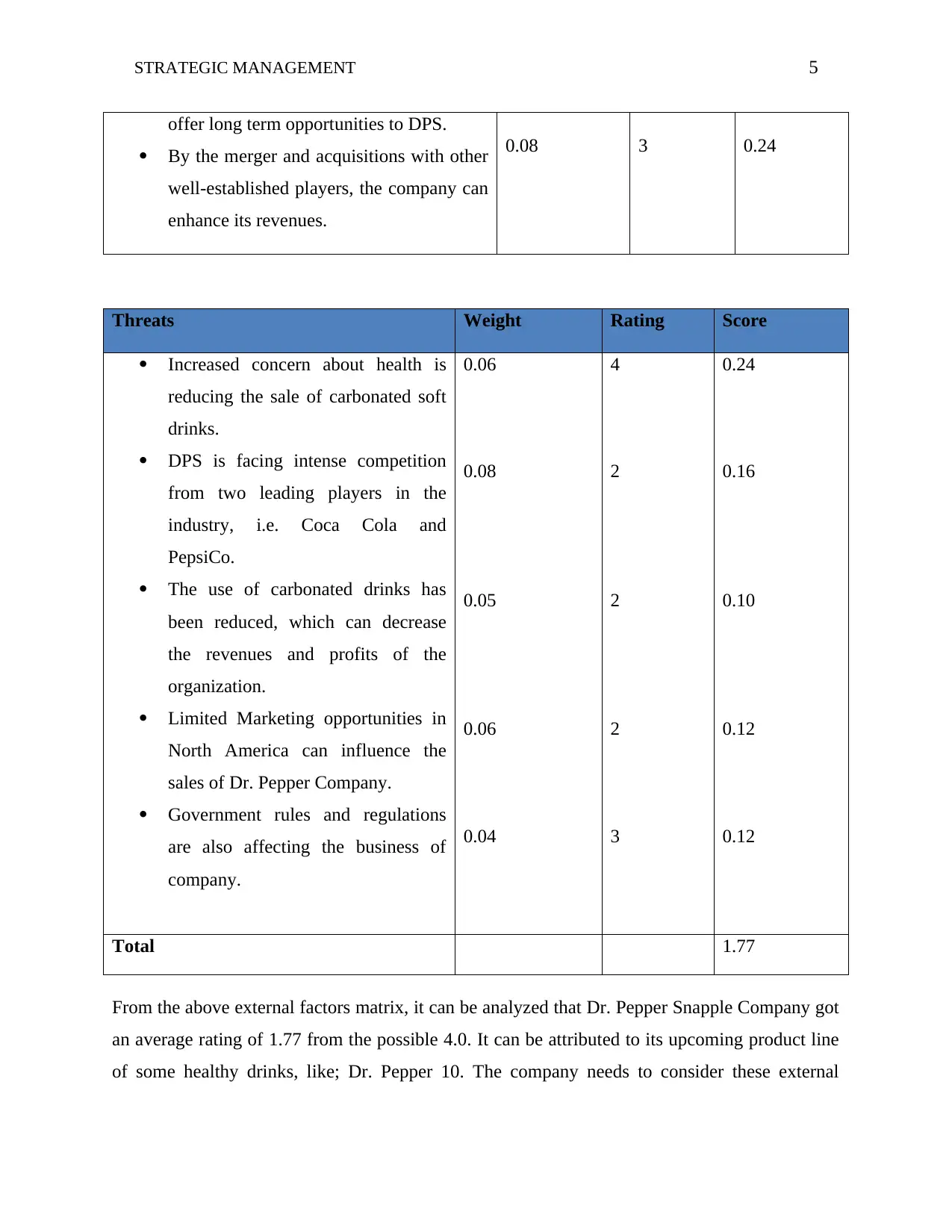
STRATEGIC MANAGEMENT 5
offer long term opportunities to DPS.
By the merger and acquisitions with other
well-established players, the company can
enhance its revenues.
0.08 3 0.24
Threats Weight Rating Score
Increased concern about health is
reducing the sale of carbonated soft
drinks.
DPS is facing intense competition
from two leading players in the
industry, i.e. Coca Cola and
PepsiCo.
The use of carbonated drinks has
been reduced, which can decrease
the revenues and profits of the
organization.
Limited Marketing opportunities in
North America can influence the
sales of Dr. Pepper Company.
Government rules and regulations
are also affecting the business of
company.
0.06
0.08
0.05
0.06
0.04
4
2
2
2
3
0.24
0.16
0.10
0.12
0.12
Total 1.77
From the above external factors matrix, it can be analyzed that Dr. Pepper Snapple Company got
an average rating of 1.77 from the possible 4.0. It can be attributed to its upcoming product line
of some healthy drinks, like; Dr. Pepper 10. The company needs to consider these external
offer long term opportunities to DPS.
By the merger and acquisitions with other
well-established players, the company can
enhance its revenues.
0.08 3 0.24
Threats Weight Rating Score
Increased concern about health is
reducing the sale of carbonated soft
drinks.
DPS is facing intense competition
from two leading players in the
industry, i.e. Coca Cola and
PepsiCo.
The use of carbonated drinks has
been reduced, which can decrease
the revenues and profits of the
organization.
Limited Marketing opportunities in
North America can influence the
sales of Dr. Pepper Company.
Government rules and regulations
are also affecting the business of
company.
0.06
0.08
0.05
0.06
0.04
4
2
2
2
3
0.24
0.16
0.10
0.12
0.12
Total 1.77
From the above external factors matrix, it can be analyzed that Dr. Pepper Snapple Company got
an average rating of 1.77 from the possible 4.0. It can be attributed to its upcoming product line
of some healthy drinks, like; Dr. Pepper 10. The company needs to consider these external
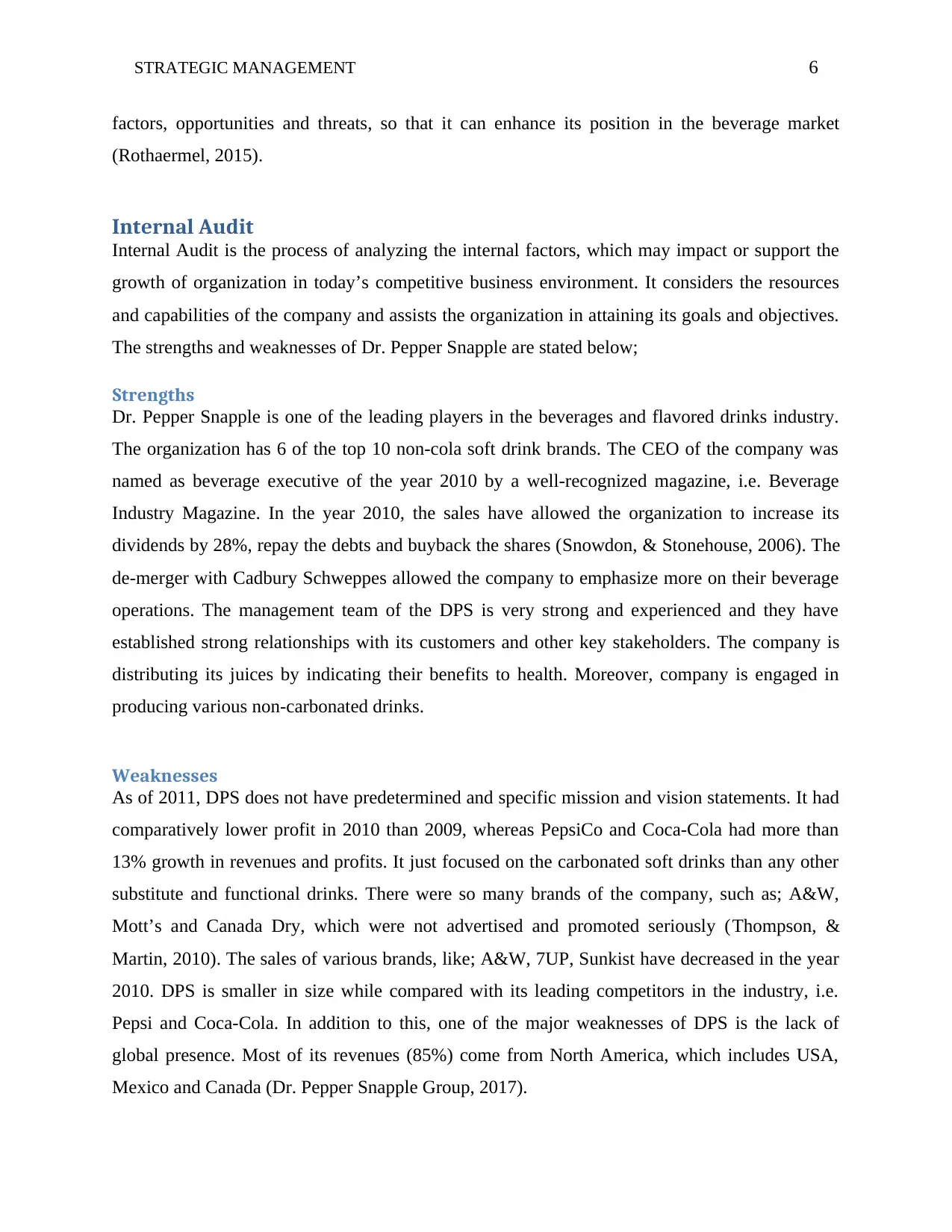
STRATEGIC MANAGEMENT 6
factors, opportunities and threats, so that it can enhance its position in the beverage market
(Rothaermel, 2015).
Internal Audit
Internal Audit is the process of analyzing the internal factors, which may impact or support the
growth of organization in today’s competitive business environment. It considers the resources
and capabilities of the company and assists the organization in attaining its goals and objectives.
The strengths and weaknesses of Dr. Pepper Snapple are stated below;
Strengths
Dr. Pepper Snapple is one of the leading players in the beverages and flavored drinks industry.
The organization has 6 of the top 10 non-cola soft drink brands. The CEO of the company was
named as beverage executive of the year 2010 by a well-recognized magazine, i.e. Beverage
Industry Magazine. In the year 2010, the sales have allowed the organization to increase its
dividends by 28%, repay the debts and buyback the shares (Snowdon, & Stonehouse, 2006). The
de-merger with Cadbury Schweppes allowed the company to emphasize more on their beverage
operations. The management team of the DPS is very strong and experienced and they have
established strong relationships with its customers and other key stakeholders. The company is
distributing its juices by indicating their benefits to health. Moreover, company is engaged in
producing various non-carbonated drinks.
Weaknesses
As of 2011, DPS does not have predetermined and specific mission and vision statements. It had
comparatively lower profit in 2010 than 2009, whereas PepsiCo and Coca-Cola had more than
13% growth in revenues and profits. It just focused on the carbonated soft drinks than any other
substitute and functional drinks. There were so many brands of the company, such as; A&W,
Mott’s and Canada Dry, which were not advertised and promoted seriously (Thompson, &
Martin, 2010). The sales of various brands, like; A&W, 7UP, Sunkist have decreased in the year
2010. DPS is smaller in size while compared with its leading competitors in the industry, i.e.
Pepsi and Coca-Cola. In addition to this, one of the major weaknesses of DPS is the lack of
global presence. Most of its revenues (85%) come from North America, which includes USA,
Mexico and Canada (Dr. Pepper Snapple Group, 2017).
factors, opportunities and threats, so that it can enhance its position in the beverage market
(Rothaermel, 2015).
Internal Audit
Internal Audit is the process of analyzing the internal factors, which may impact or support the
growth of organization in today’s competitive business environment. It considers the resources
and capabilities of the company and assists the organization in attaining its goals and objectives.
The strengths and weaknesses of Dr. Pepper Snapple are stated below;
Strengths
Dr. Pepper Snapple is one of the leading players in the beverages and flavored drinks industry.
The organization has 6 of the top 10 non-cola soft drink brands. The CEO of the company was
named as beverage executive of the year 2010 by a well-recognized magazine, i.e. Beverage
Industry Magazine. In the year 2010, the sales have allowed the organization to increase its
dividends by 28%, repay the debts and buyback the shares (Snowdon, & Stonehouse, 2006). The
de-merger with Cadbury Schweppes allowed the company to emphasize more on their beverage
operations. The management team of the DPS is very strong and experienced and they have
established strong relationships with its customers and other key stakeholders. The company is
distributing its juices by indicating their benefits to health. Moreover, company is engaged in
producing various non-carbonated drinks.
Weaknesses
As of 2011, DPS does not have predetermined and specific mission and vision statements. It had
comparatively lower profit in 2010 than 2009, whereas PepsiCo and Coca-Cola had more than
13% growth in revenues and profits. It just focused on the carbonated soft drinks than any other
substitute and functional drinks. There were so many brands of the company, such as; A&W,
Mott’s and Canada Dry, which were not advertised and promoted seriously (Thompson, &
Martin, 2010). The sales of various brands, like; A&W, 7UP, Sunkist have decreased in the year
2010. DPS is smaller in size while compared with its leading competitors in the industry, i.e.
Pepsi and Coca-Cola. In addition to this, one of the major weaknesses of DPS is the lack of
global presence. Most of its revenues (85%) come from North America, which includes USA,
Mexico and Canada (Dr. Pepper Snapple Group, 2017).
⊘ This is a preview!⊘
Do you want full access?
Subscribe today to unlock all pages.

Trusted by 1+ million students worldwide
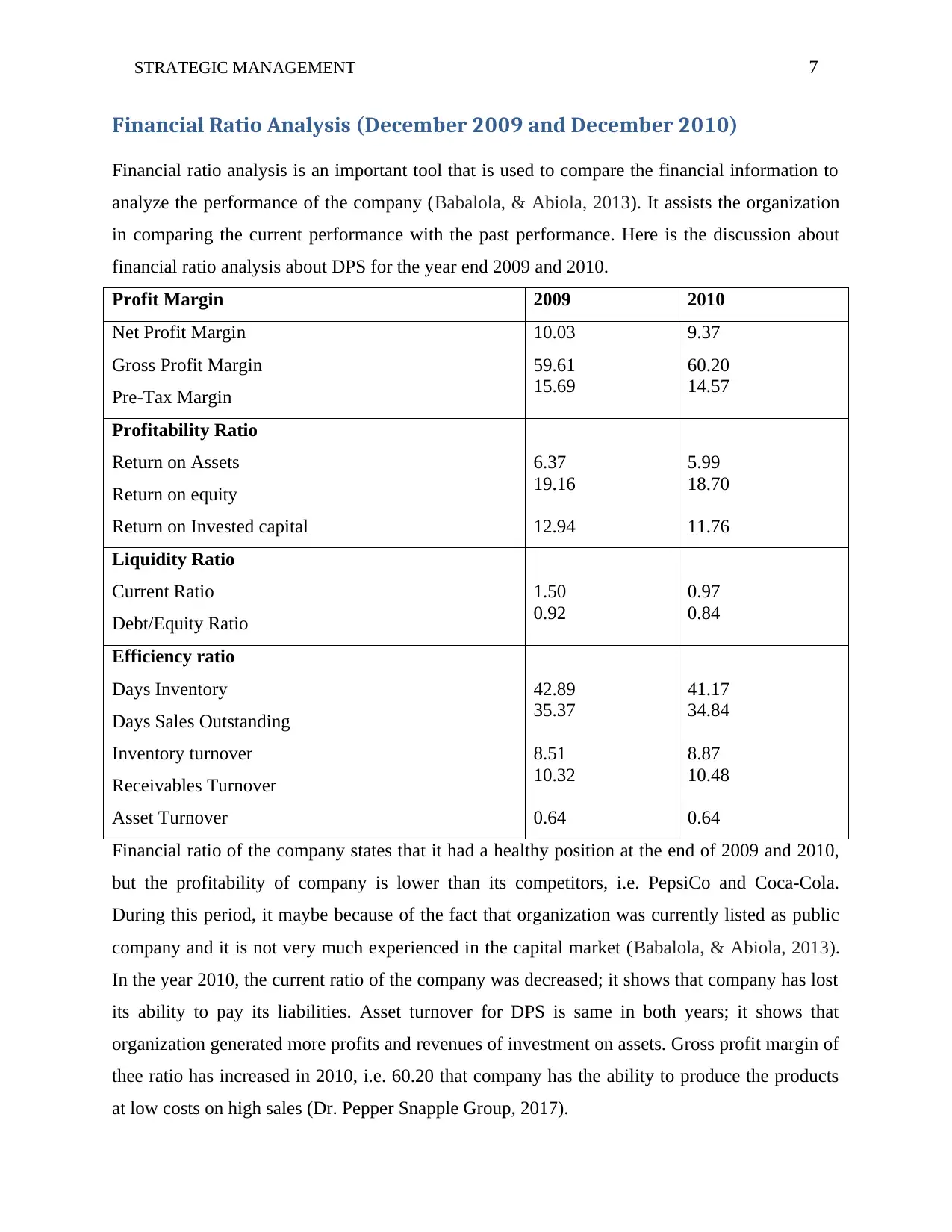
STRATEGIC MANAGEMENT 7
Financial Ratio Analysis (December 2009 and December 2010)
Financial ratio analysis is an important tool that is used to compare the financial information to
analyze the performance of the company (Babalola, & Abiola, 2013). It assists the organization
in comparing the current performance with the past performance. Here is the discussion about
financial ratio analysis about DPS for the year end 2009 and 2010.
Profit Margin 2009 2010
Net Profit Margin
Gross Profit Margin
Pre-Tax Margin
10.03
59.61
15.69
9.37
60.20
14.57
Profitability Ratio
Return on Assets
Return on equity
Return on Invested capital
6.37
19.16
12.94
5.99
18.70
11.76
Liquidity Ratio
Current Ratio
Debt/Equity Ratio
1.50
0.92
0.97
0.84
Efficiency ratio
Days Inventory
Days Sales Outstanding
Inventory turnover
Receivables Turnover
Asset Turnover
42.89
35.37
8.51
10.32
0.64
41.17
34.84
8.87
10.48
0.64
Financial ratio of the company states that it had a healthy position at the end of 2009 and 2010,
but the profitability of company is lower than its competitors, i.e. PepsiCo and Coca-Cola.
During this period, it maybe because of the fact that organization was currently listed as public
company and it is not very much experienced in the capital market (Babalola, & Abiola, 2013).
In the year 2010, the current ratio of the company was decreased; it shows that company has lost
its ability to pay its liabilities. Asset turnover for DPS is same in both years; it shows that
organization generated more profits and revenues of investment on assets. Gross profit margin of
thee ratio has increased in 2010, i.e. 60.20 that company has the ability to produce the products
at low costs on high sales (Dr. Pepper Snapple Group, 2017).
Financial Ratio Analysis (December 2009 and December 2010)
Financial ratio analysis is an important tool that is used to compare the financial information to
analyze the performance of the company (Babalola, & Abiola, 2013). It assists the organization
in comparing the current performance with the past performance. Here is the discussion about
financial ratio analysis about DPS for the year end 2009 and 2010.
Profit Margin 2009 2010
Net Profit Margin
Gross Profit Margin
Pre-Tax Margin
10.03
59.61
15.69
9.37
60.20
14.57
Profitability Ratio
Return on Assets
Return on equity
Return on Invested capital
6.37
19.16
12.94
5.99
18.70
11.76
Liquidity Ratio
Current Ratio
Debt/Equity Ratio
1.50
0.92
0.97
0.84
Efficiency ratio
Days Inventory
Days Sales Outstanding
Inventory turnover
Receivables Turnover
Asset Turnover
42.89
35.37
8.51
10.32
0.64
41.17
34.84
8.87
10.48
0.64
Financial ratio of the company states that it had a healthy position at the end of 2009 and 2010,
but the profitability of company is lower than its competitors, i.e. PepsiCo and Coca-Cola.
During this period, it maybe because of the fact that organization was currently listed as public
company and it is not very much experienced in the capital market (Babalola, & Abiola, 2013).
In the year 2010, the current ratio of the company was decreased; it shows that company has lost
its ability to pay its liabilities. Asset turnover for DPS is same in both years; it shows that
organization generated more profits and revenues of investment on assets. Gross profit margin of
thee ratio has increased in 2010, i.e. 60.20 that company has the ability to produce the products
at low costs on high sales (Dr. Pepper Snapple Group, 2017).
Paraphrase This Document
Need a fresh take? Get an instant paraphrase of this document with our AI Paraphraser
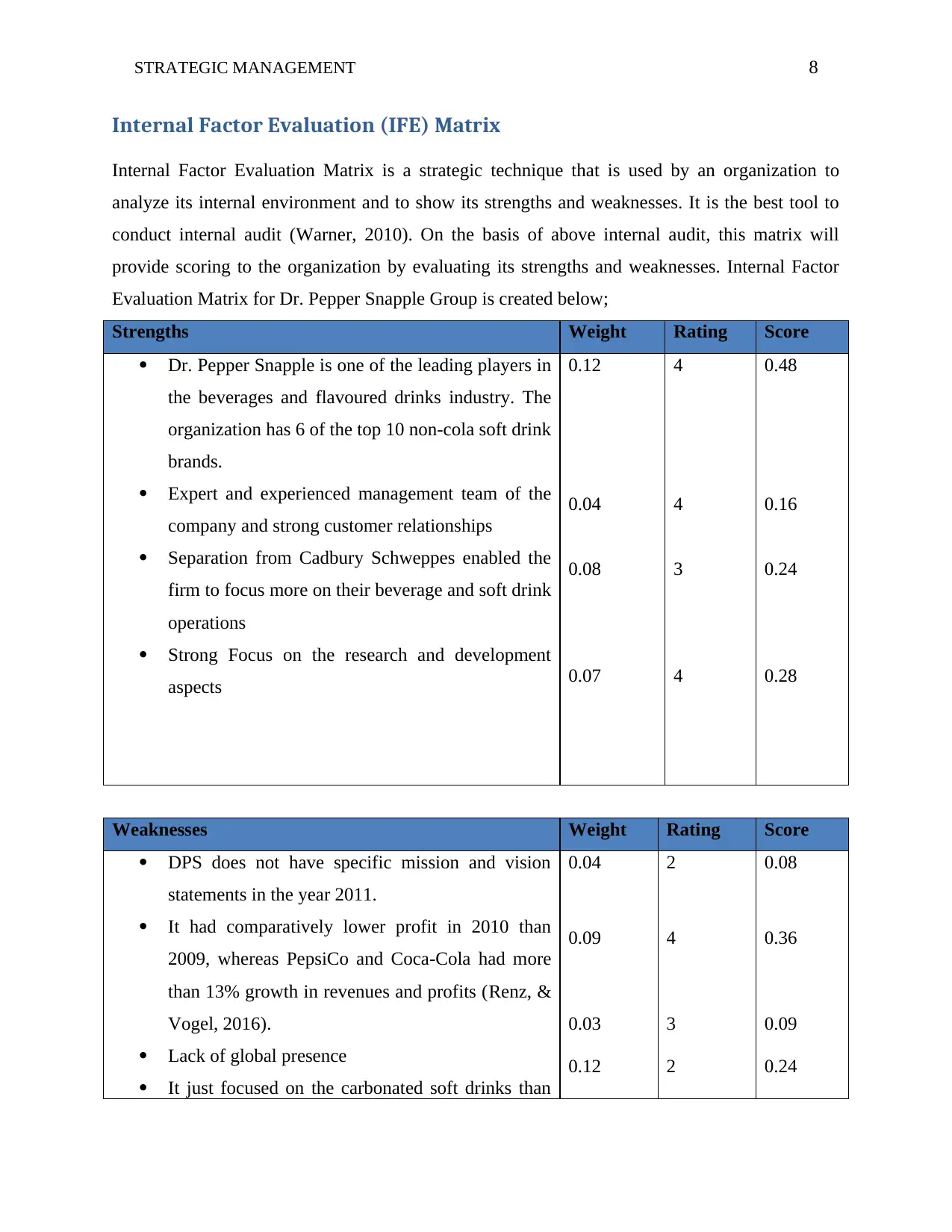
STRATEGIC MANAGEMENT 8
Internal Factor Evaluation (IFE) Matrix
Internal Factor Evaluation Matrix is a strategic technique that is used by an organization to
analyze its internal environment and to show its strengths and weaknesses. It is the best tool to
conduct internal audit (Warner, 2010). On the basis of above internal audit, this matrix will
provide scoring to the organization by evaluating its strengths and weaknesses. Internal Factor
Evaluation Matrix for Dr. Pepper Snapple Group is created below;
Strengths Weight Rating Score
Dr. Pepper Snapple is one of the leading players in
the beverages and flavoured drinks industry. The
organization has 6 of the top 10 non-cola soft drink
brands.
Expert and experienced management team of the
company and strong customer relationships
Separation from Cadbury Schweppes enabled the
firm to focus more on their beverage and soft drink
operations
Strong Focus on the research and development
aspects
0.12
0.04
0.08
0.07
4
4
3
4
0.48
0.16
0.24
0.28
Weaknesses Weight Rating Score
DPS does not have specific mission and vision
statements in the year 2011.
It had comparatively lower profit in 2010 than
2009, whereas PepsiCo and Coca-Cola had more
than 13% growth in revenues and profits (Renz, &
Vogel, 2016).
Lack of global presence
It just focused on the carbonated soft drinks than
0.04
0.09
0.03
0.12
2
4
3
2
0.08
0.36
0.09
0.24
Internal Factor Evaluation (IFE) Matrix
Internal Factor Evaluation Matrix is a strategic technique that is used by an organization to
analyze its internal environment and to show its strengths and weaknesses. It is the best tool to
conduct internal audit (Warner, 2010). On the basis of above internal audit, this matrix will
provide scoring to the organization by evaluating its strengths and weaknesses. Internal Factor
Evaluation Matrix for Dr. Pepper Snapple Group is created below;
Strengths Weight Rating Score
Dr. Pepper Snapple is one of the leading players in
the beverages and flavoured drinks industry. The
organization has 6 of the top 10 non-cola soft drink
brands.
Expert and experienced management team of the
company and strong customer relationships
Separation from Cadbury Schweppes enabled the
firm to focus more on their beverage and soft drink
operations
Strong Focus on the research and development
aspects
0.12
0.04
0.08
0.07
4
4
3
4
0.48
0.16
0.24
0.28
Weaknesses Weight Rating Score
DPS does not have specific mission and vision
statements in the year 2011.
It had comparatively lower profit in 2010 than
2009, whereas PepsiCo and Coca-Cola had more
than 13% growth in revenues and profits (Renz, &
Vogel, 2016).
Lack of global presence
It just focused on the carbonated soft drinks than
0.04
0.09
0.03
0.12
2
4
3
2
0.08
0.36
0.09
0.24
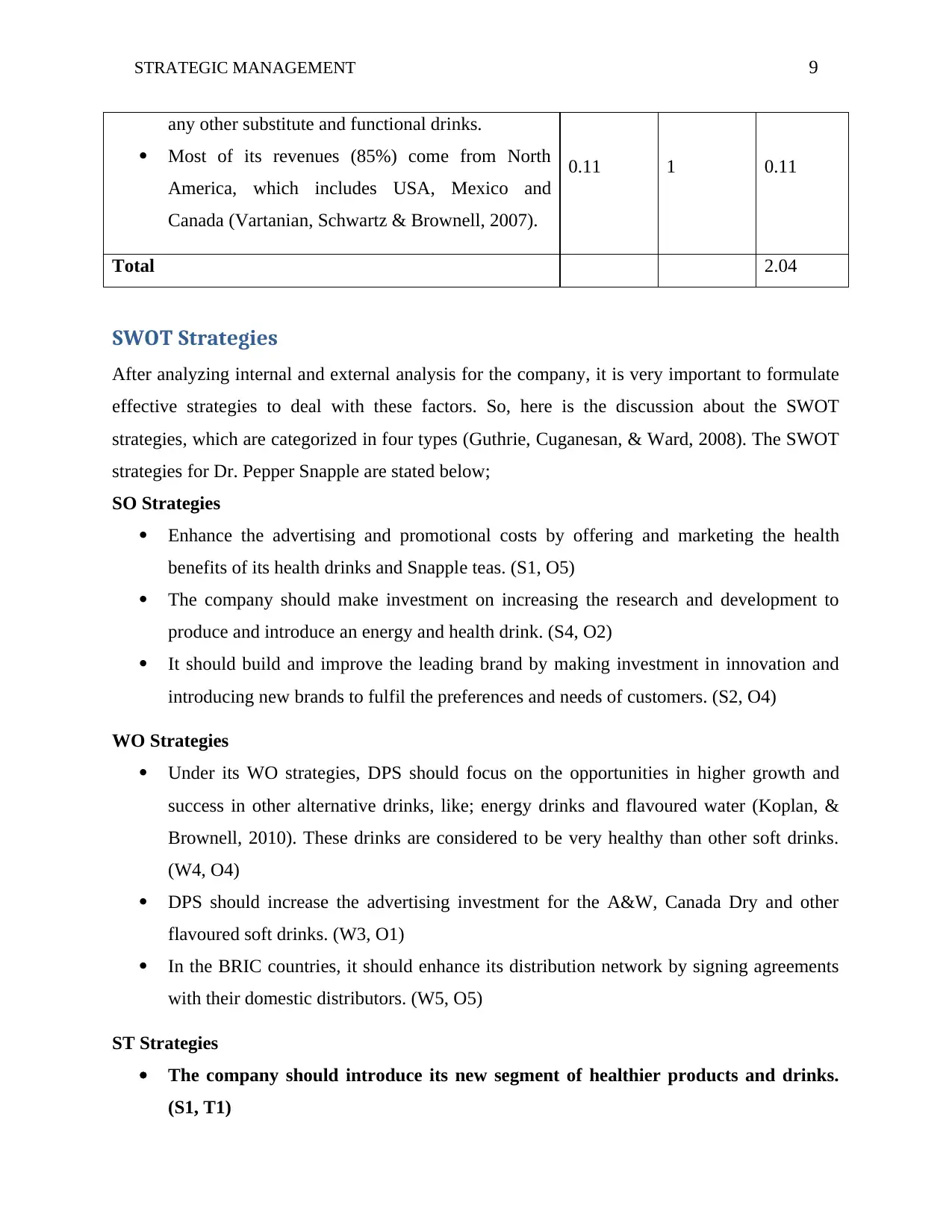
STRATEGIC MANAGEMENT 9
any other substitute and functional drinks.
Most of its revenues (85%) come from North
America, which includes USA, Mexico and
Canada (Vartanian, Schwartz & Brownell, 2007).
0.11 1 0.11
Total 2.04
SWOT Strategies
After analyzing internal and external analysis for the company, it is very important to formulate
effective strategies to deal with these factors. So, here is the discussion about the SWOT
strategies, which are categorized in four types (Guthrie, Cuganesan, & Ward, 2008). The SWOT
strategies for Dr. Pepper Snapple are stated below;
SO Strategies
Enhance the advertising and promotional costs by offering and marketing the health
benefits of its health drinks and Snapple teas. (S1, O5)
The company should make investment on increasing the research and development to
produce and introduce an energy and health drink. (S4, O2)
It should build and improve the leading brand by making investment in innovation and
introducing new brands to fulfil the preferences and needs of customers. (S2, O4)
WO Strategies
Under its WO strategies, DPS should focus on the opportunities in higher growth and
success in other alternative drinks, like; energy drinks and flavoured water (Koplan, &
Brownell, 2010). These drinks are considered to be very healthy than other soft drinks.
(W4, O4)
DPS should increase the advertising investment for the A&W, Canada Dry and other
flavoured soft drinks. (W3, O1)
In the BRIC countries, it should enhance its distribution network by signing agreements
with their domestic distributors. (W5, O5)
ST Strategies
The company should introduce its new segment of healthier products and drinks.
(S1, T1)
any other substitute and functional drinks.
Most of its revenues (85%) come from North
America, which includes USA, Mexico and
Canada (Vartanian, Schwartz & Brownell, 2007).
0.11 1 0.11
Total 2.04
SWOT Strategies
After analyzing internal and external analysis for the company, it is very important to formulate
effective strategies to deal with these factors. So, here is the discussion about the SWOT
strategies, which are categorized in four types (Guthrie, Cuganesan, & Ward, 2008). The SWOT
strategies for Dr. Pepper Snapple are stated below;
SO Strategies
Enhance the advertising and promotional costs by offering and marketing the health
benefits of its health drinks and Snapple teas. (S1, O5)
The company should make investment on increasing the research and development to
produce and introduce an energy and health drink. (S4, O2)
It should build and improve the leading brand by making investment in innovation and
introducing new brands to fulfil the preferences and needs of customers. (S2, O4)
WO Strategies
Under its WO strategies, DPS should focus on the opportunities in higher growth and
success in other alternative drinks, like; energy drinks and flavoured water (Koplan, &
Brownell, 2010). These drinks are considered to be very healthy than other soft drinks.
(W4, O4)
DPS should increase the advertising investment for the A&W, Canada Dry and other
flavoured soft drinks. (W3, O1)
In the BRIC countries, it should enhance its distribution network by signing agreements
with their domestic distributors. (W5, O5)
ST Strategies
The company should introduce its new segment of healthier products and drinks.
(S1, T1)
⊘ This is a preview!⊘
Do you want full access?
Subscribe today to unlock all pages.

Trusted by 1+ million students worldwide

STRATEGIC MANAGEMENT 10
It should conduct a market research to analyse the competitors and their strategies that
will assist the organization in gaining more competitive advantage over leading
competitors, i.e. Coca-Cola and PepsiCo. (S1, T2)
It can use management expertise at the disposal for optimizing the operation costs and fix
the competitive prices. (S2, T3)
In addition to this, it can increase the advertising and promotion of Snapple Tea and other
juice products (Andreyeva, Kelly & Harris, 2011). (S4, T1, T3)
WT Strategies
DPS should execute aggressive advertisement to deal with the intense competition from
PepsiCo and Coca-Cola in international market. (W2, W3, T2)
By introducing a flavoured water product line, DPS can diversify its product range. (W4,
T3)
There should be a creative and innovative range of functional products, like; coffee,
energy beverages, tea etc. (W4, T3)
SPACE Matrix
SPACE (Strategic Position and Active Evaluation) Matrix is the management technique that is
used to analyze an organization. It is used to decide that what type of strategy an organization
should implement. Companies implement this tool for formulating the strategy, especially related
to the competitive position of organization (Dubé, 2005). The below-given diagram shows the
SPACE matrix of DPS, which shows that DPS falls under the aggressive quadrant of SPACE
matrix.
It should conduct a market research to analyse the competitors and their strategies that
will assist the organization in gaining more competitive advantage over leading
competitors, i.e. Coca-Cola and PepsiCo. (S1, T2)
It can use management expertise at the disposal for optimizing the operation costs and fix
the competitive prices. (S2, T3)
In addition to this, it can increase the advertising and promotion of Snapple Tea and other
juice products (Andreyeva, Kelly & Harris, 2011). (S4, T1, T3)
WT Strategies
DPS should execute aggressive advertisement to deal with the intense competition from
PepsiCo and Coca-Cola in international market. (W2, W3, T2)
By introducing a flavoured water product line, DPS can diversify its product range. (W4,
T3)
There should be a creative and innovative range of functional products, like; coffee,
energy beverages, tea etc. (W4, T3)
SPACE Matrix
SPACE (Strategic Position and Active Evaluation) Matrix is the management technique that is
used to analyze an organization. It is used to decide that what type of strategy an organization
should implement. Companies implement this tool for formulating the strategy, especially related
to the competitive position of organization (Dubé, 2005). The below-given diagram shows the
SPACE matrix of DPS, which shows that DPS falls under the aggressive quadrant of SPACE
matrix.
Paraphrase This Document
Need a fresh take? Get an instant paraphrase of this document with our AI Paraphraser
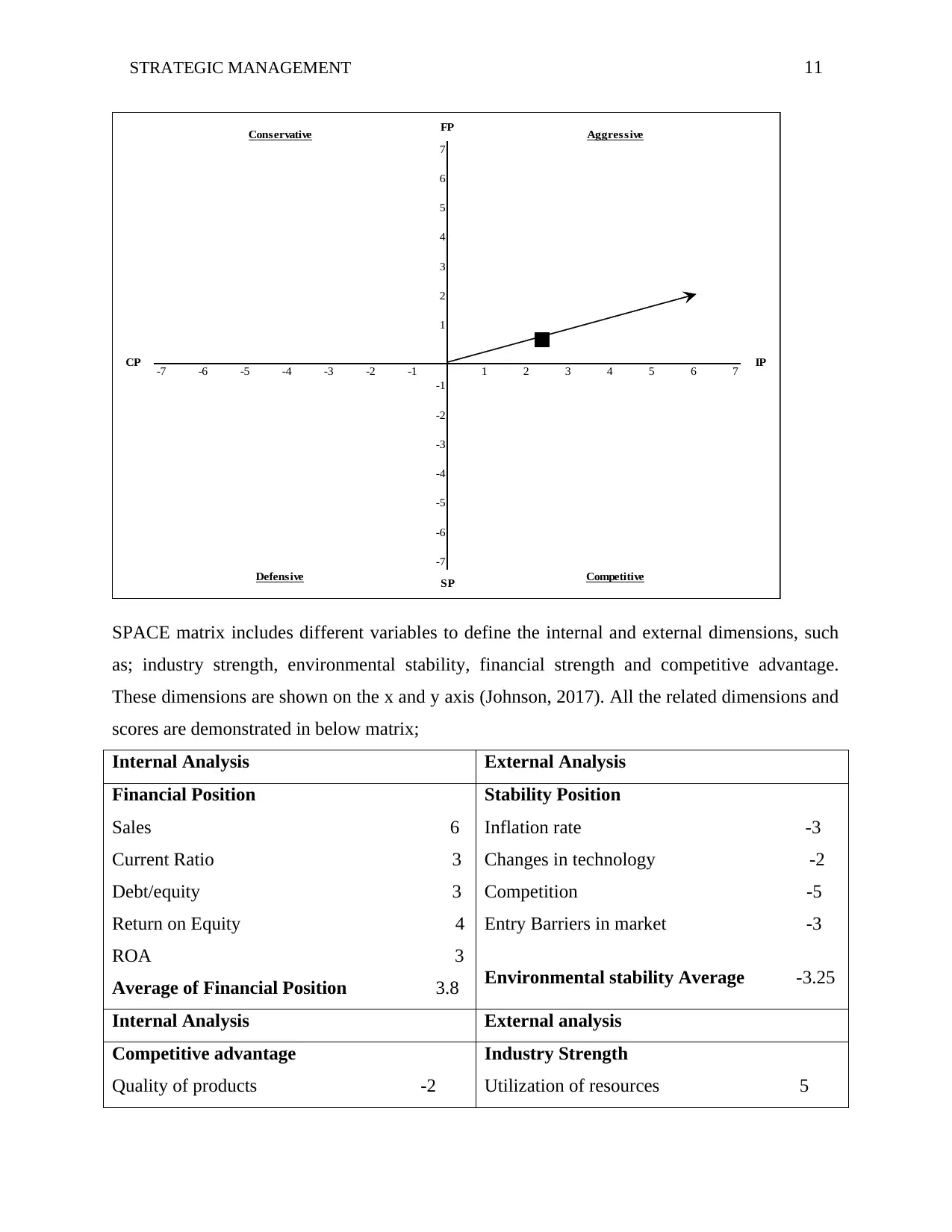
STRATEGIC MANAGEMENT 11
7
6
5
4
3
2
1
-7 -6 -5 -4 -3 -2 -1 1 2 3 4 5 6 7
-1
-2
-3
-4
-5
-6
-7
IPCP
Defensive
AggressiveConservative FP
Competitive
SP
SPACE matrix includes different variables to define the internal and external dimensions, such
as; industry strength, environmental stability, financial strength and competitive advantage.
These dimensions are shown on the x and y axis (Johnson, 2017). All the related dimensions and
scores are demonstrated in below matrix;
Internal Analysis External Analysis
Financial Position
Sales 6
Current Ratio 3
Debt/equity 3
Return on Equity 4
ROA 3
Average of Financial Position 3.8
Stability Position
Inflation rate -3
Changes in technology -2
Competition -5
Entry Barriers in market -3
Environmental stability Average -3.25
Internal Analysis External analysis
Competitive advantage
Quality of products -2
Industry Strength
Utilization of resources 5
7
6
5
4
3
2
1
-7 -6 -5 -4 -3 -2 -1 1 2 3 4 5 6 7
-1
-2
-3
-4
-5
-6
-7
IPCP
Defensive
AggressiveConservative FP
Competitive
SP
SPACE matrix includes different variables to define the internal and external dimensions, such
as; industry strength, environmental stability, financial strength and competitive advantage.
These dimensions are shown on the x and y axis (Johnson, 2017). All the related dimensions and
scores are demonstrated in below matrix;
Internal Analysis External Analysis
Financial Position
Sales 6
Current Ratio 3
Debt/equity 3
Return on Equity 4
ROA 3
Average of Financial Position 3.8
Stability Position
Inflation rate -3
Changes in technology -2
Competition -5
Entry Barriers in market -3
Environmental stability Average -3.25
Internal Analysis External analysis
Competitive advantage
Quality of products -2
Industry Strength
Utilization of resources 5
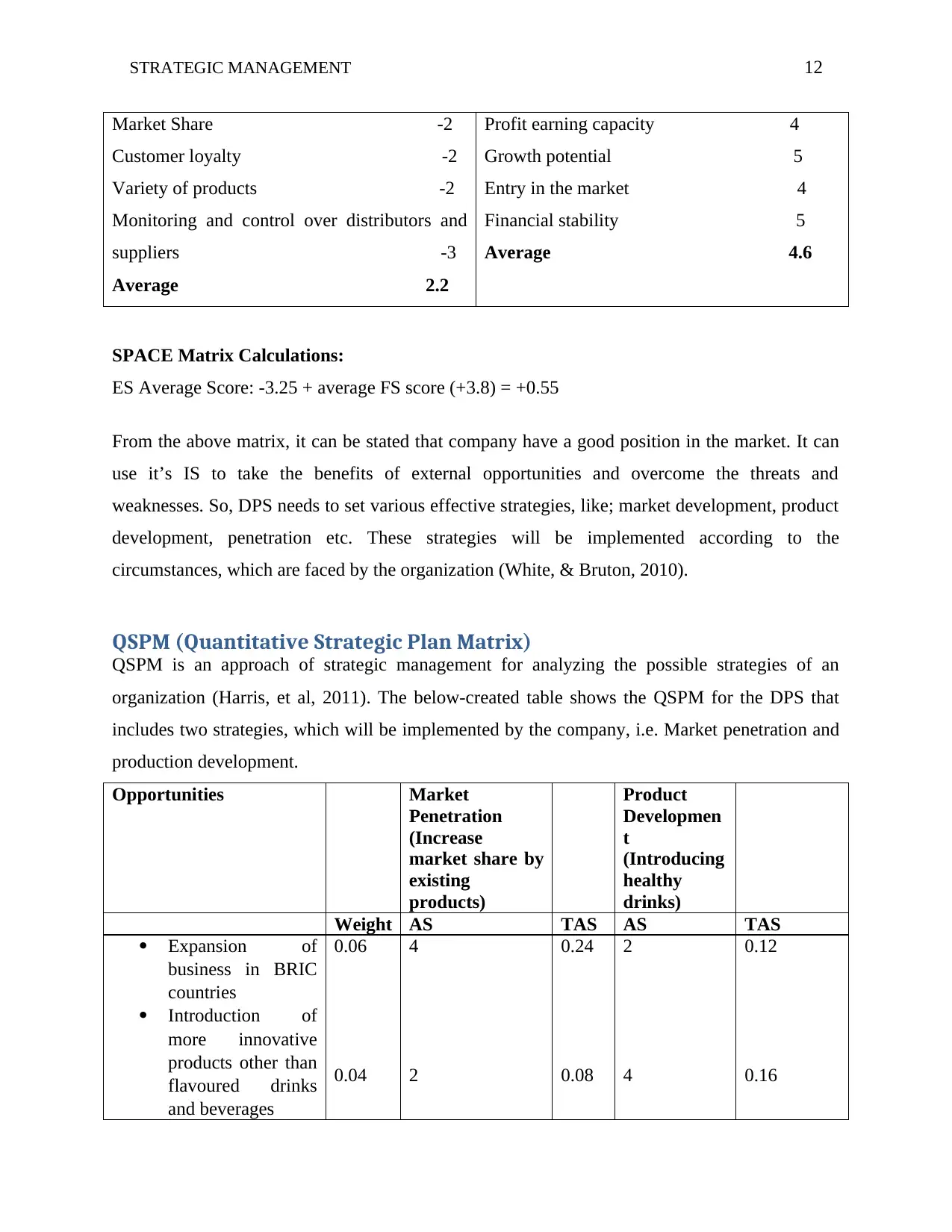
STRATEGIC MANAGEMENT 12
Market Share -2
Customer loyalty -2
Variety of products -2
Monitoring and control over distributors and
suppliers -3
Average 2.2
Profit earning capacity 4
Growth potential 5
Entry in the market 4
Financial stability 5
Average 4.6
SPACE Matrix Calculations:
ES Average Score: -3.25 + average FS score (+3.8) = +0.55
From the above matrix, it can be stated that company have a good position in the market. It can
use it’s IS to take the benefits of external opportunities and overcome the threats and
weaknesses. So, DPS needs to set various effective strategies, like; market development, product
development, penetration etc. These strategies will be implemented according to the
circumstances, which are faced by the organization (White, & Bruton, 2010).
QSPM (Quantitative Strategic Plan Matrix)
QSPM is an approach of strategic management for analyzing the possible strategies of an
organization (Harris, et al, 2011). The below-created table shows the QSPM for the DPS that
includes two strategies, which will be implemented by the company, i.e. Market penetration and
production development.
Opportunities Market
Penetration
(Increase
market share by
existing
products)
Product
Developmen
t
(Introducing
healthy
drinks)
Weight AS TAS AS TAS
Expansion of
business in BRIC
countries
Introduction of
more innovative
products other than
flavoured drinks
and beverages
0.06
0.04
4
2
0.24
0.08
2
4
0.12
0.16
Market Share -2
Customer loyalty -2
Variety of products -2
Monitoring and control over distributors and
suppliers -3
Average 2.2
Profit earning capacity 4
Growth potential 5
Entry in the market 4
Financial stability 5
Average 4.6
SPACE Matrix Calculations:
ES Average Score: -3.25 + average FS score (+3.8) = +0.55
From the above matrix, it can be stated that company have a good position in the market. It can
use it’s IS to take the benefits of external opportunities and overcome the threats and
weaknesses. So, DPS needs to set various effective strategies, like; market development, product
development, penetration etc. These strategies will be implemented according to the
circumstances, which are faced by the organization (White, & Bruton, 2010).
QSPM (Quantitative Strategic Plan Matrix)
QSPM is an approach of strategic management for analyzing the possible strategies of an
organization (Harris, et al, 2011). The below-created table shows the QSPM for the DPS that
includes two strategies, which will be implemented by the company, i.e. Market penetration and
production development.
Opportunities Market
Penetration
(Increase
market share by
existing
products)
Product
Developmen
t
(Introducing
healthy
drinks)
Weight AS TAS AS TAS
Expansion of
business in BRIC
countries
Introduction of
more innovative
products other than
flavoured drinks
and beverages
0.06
0.04
4
2
0.24
0.08
2
4
0.12
0.16
⊘ This is a preview!⊘
Do you want full access?
Subscribe today to unlock all pages.

Trusted by 1+ million students worldwide
1 out of 17
Related Documents
Your All-in-One AI-Powered Toolkit for Academic Success.
+13062052269
info@desklib.com
Available 24*7 on WhatsApp / Email
![[object Object]](/_next/static/media/star-bottom.7253800d.svg)
Unlock your academic potential
Copyright © 2020–2025 A2Z Services. All Rights Reserved. Developed and managed by ZUCOL.





